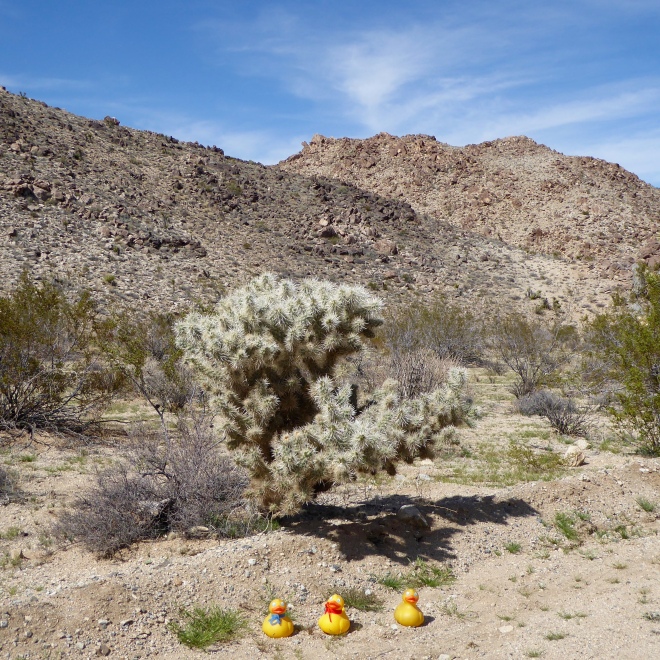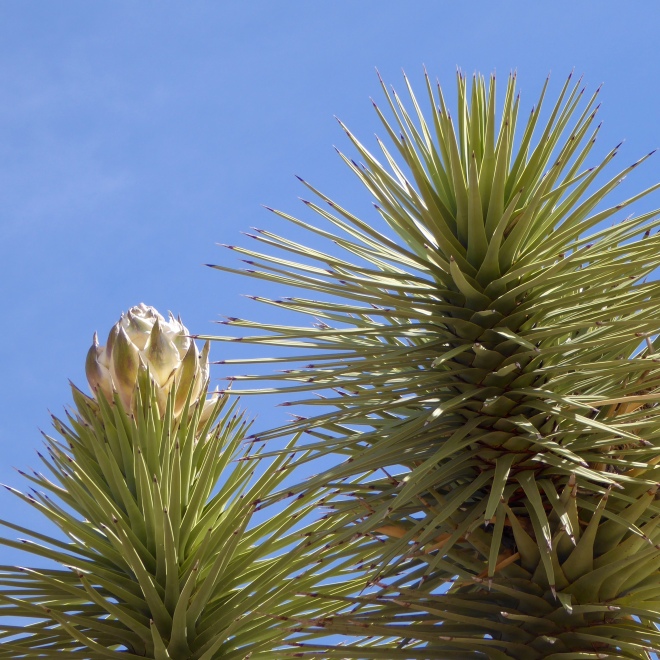In the desert of southeast California, we entered Joshua Tree National Park.
As you know, this is the 100th anniversary of the National Park Service, so we are visiting some national parks this year. The desert has so many types of vegetation and pretty cactus.
This silver one caught our attention. The western part of Joshua Tree National Park is in the Mojave Desert. This desert is more than 3,000 feet above sea level. This is a Joshua Tree.
Joshua trees are really a species of yucca plant and are a symbol of the Mojave Desert. The waxy, spiny leaves expose little surface area, efficiently conserving moisture. Joshua trees can grow over 40 feet tall–at the leisurely rate of an inch a year. Our Joshua Tree has flowers.
Joshua Trees bloom February through April. The flower is pollinated only by the Joshua moth, and branching occurs after flowering. These trees are not scarce in Joshua Tree National Park, nor in the Mojave Desert.
They are referred to as the Tree of Life, similar to the Saguaro cactus in the Sonoran Desert. The rock formations here are great also. This is Skull Rock.
You know how it received that name. The rocks were formed by underground volcanic activity eons ago and have evolved to todays rock formations.
We love them. The eastern part of Joshua Tree National Park is in the Colorado Desert. This desert is less than 3,000 above sea level. The Colorado Desert is a lower, hotter and drier desert than the Mojave Desert. The Colorado Desert is a sub division of the Sonoran Desert. Of course there are no boundaries between the deserts, just a subtle, gradual change and the appearance of lower creosote bushes.
There are many Cholla Cactus here.
This fenced area is called the Cholla Cactus Garden. Let’s go explore.
The signs say not to touch the cactus, or even get too close. The needles cause pain–going in and coming out of your body. Here is new growth on the cactus.
When the needles turn brown and fall off, the remaining cactus arm resembles woven, hollow stalks.
Even though this is a sub division of the Sonoran Desert, the large cactus do not appear. We did like this desert plant with the huge flowering blossom.
The desert is just so full of different vegetation and so many surprises. We hope you visit Joshua Tree National Park, or some national parks in this, the Centennial year, of the National Park Service.














I don’t think I would need reminding not to touch those cacti. They look fierce.
We were not the last bit tempted to touch. I am no fan of pain. Thanks for reading and commenting.
Stunning. Thank you. 🌵
Thank you. It is a fascinating park. Thanks for reading and commenting.